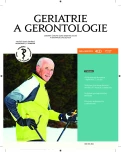Prevention of osteoporosis and sarcopenia
Authors:
H. Matějovská Kubešová
Authors‘ workplace:
Klinika interní, geriatrie a praktického lékařství LF MU a FN Brno
Published in:
Geriatrie a Gerontologie 2013, 2, č. 4: 213-215
Category:
Review Article
Overview
This review presents an overview of the available information concerning pathogenesis of osteoporosis, relationship between peak bone mass, bone remodelling and the loss of bone mass. Main risk factors are mentioned as well as additional potentiating factors. Special attention is paid to possible kinds of prevention. Sarcopenia is discussed as one of the main factors of loss of independency – its pathogenesis, potentiating factors, prevention and treatment.
Keywords:
osteoporosis – bone remodelation – risk factors – sarcopenia – independency
Sources
1. Topinková E: Geriatrie pro praxi. Galén 2005.
2. Kalvach Z, Zadák Z, Jirák R et al.: Gerontologie a geriatrie. Grada Avicenum 2005.
3. Gass ML, Heights M, Manson JE et al.: The 2012 hormone therapy position statement of The North American Menopause Society. Menopause 2012; 19(3): 257–71.
4. Suchy FJ, Brannon PM, Carpenter TO et al.: NIH consensus development conference statement: Lactose intolerance and health. NIH Consens State Sci Statements 2010; 27(2): 1–27.
5. Kearney DM, Lockey RF et al.: Osteoporosis and asthma. Ann Allergy Asthma Immunol 2006; 96(6): 769–74.
6. Thanou A, Ali T, Haq O et al.: Utilization of preventive measures for glucocorticoid-induced osteoporosis among veterans with inflammatory bowel disease. ISRN Gastroenterol 2013: 862312.
7. Marzetti E, Privitera G, Simili V et al.: Multiple pathways to the same end: mechanisms of myonuclear apoptosis in sarcopenia of aging. Scientific World Journal 2010; 19(10): 340–349.
8. Clark BC, Manini TM: Functional consequences of sarcopenia and dynapenia in the elderly. Curr Opin Clin Nutr Metab Care 2010; 13(3): 271–276.
9. Rossi P, Marzani B, Giardina S et al.: Human skeletal muscle aging and the oxidative system: cellular events. Curr Aging Sci 2008; 1(3): 182–91.
10. Jones TE, Stephenson KW, King JG et al.: Sarcopenia-mechanisms and treatments. J Geriatr Phys Ther 2009; 32(2): 39–45.
11. Sjöblom S, Suuronen J, Rikkonen T et al.: Relationship between postmenopausal osteoporosis and the components of clinical sarcopenia. Maturitas 2013; 75(2): 175–80.
12. Ochi M, Tabara Y, Kido T et al.: Quadriceps sarcopenia and visceral obesity are risk factors for postural instability in the middle-aged to elderly population. Geriatr Gerontol Int 2010; 10(3): 233–243.
13. Iaboni A, Flint AJ: The complex interplay of depression and falls in older adults: a clinical review. Am J Geriatr Psychiatry 2013; 21(5): 484–92.
14. Sakuma K, Yamaguchi A: Molecular mechanisms in aging and current strategies to counteract sarcopenia. Curr Aging Sci 2010; 3(2): 90–101.
15. Fujita S, Volpi E: Amino acids and muscle loss with aging. J Nutr 2006; 136, suppl 1: 277–280.
16. Bautmans I, Van Puyvelde K, Mets T: Sarcopenia and functional decline: pathophysiology, prevention and therapy. Acta Clin Belg 2009; 64(4): 303–16.
17. Kim JS, Wilson JM, Lee SR: Dietary implications on mechanisms of sarcopenia: roles of protein, amino acids and antioxidants. J Nutr Biochem 2010; 21(1): 1–13.
18. Evans WJ: Skeletal muscle loss: cachexia, sarcopenia, and inactivity. Am J Clin Nutr 2010; 91(4): 1123S–1127S.
Labels
Geriatrics General practitioner for adults Orthopaedic prostheticsArticle was published in
Geriatrics and Gerontology

2013 Issue 4
Most read in this issue
- Prophylaxis of thromboembolism
- Prophylaxis of post-traumatic epilepsy
- Risk factors for venous thrombosis
- Alzheimer‘s dementia – a 21th century epidemic: can we prevent it?
